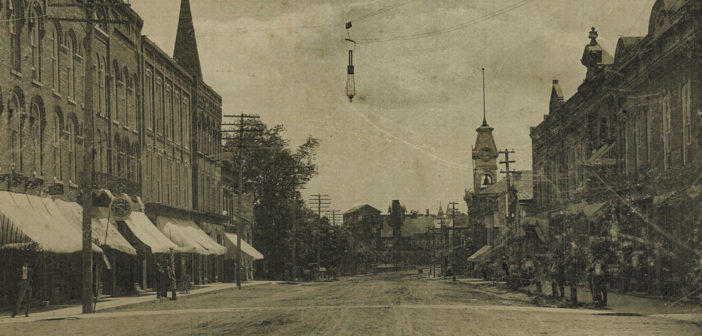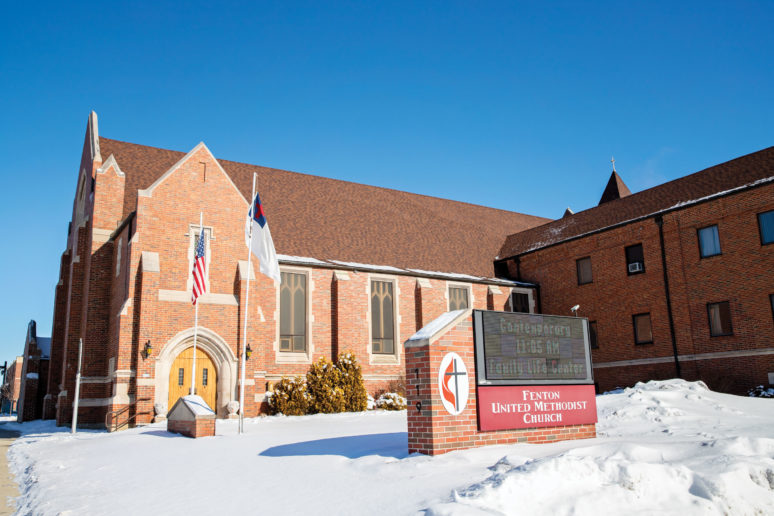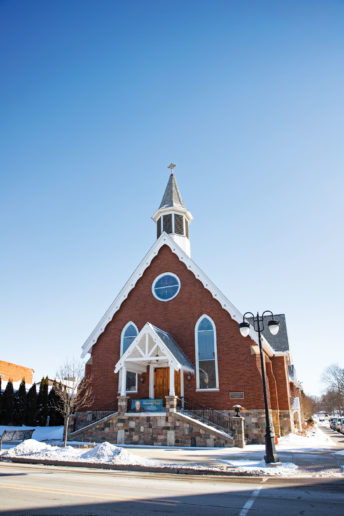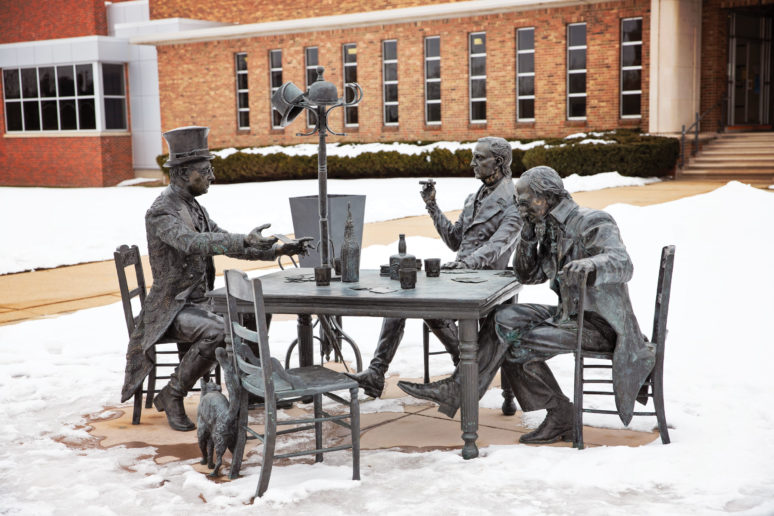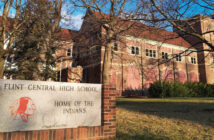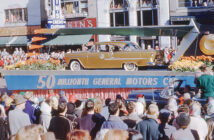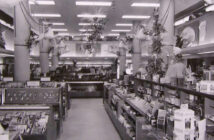This series profiles the beginning and history of the towns and cities surrounding Flint in Genesee County. The profiles will be presented according to the earliest known settlement year. Major highlights will include founding, notable personage, major events, noted locations and businesses.
The Early Pioneers
The crowd was jubilant and music filled the air. Uncle Dick Donaldson’s Band worked the fiddles, backed by Elisha Larned playing the tumblers and decanters behind the bar. Everyone in the newly christened “Fentonville” showed up to have a good time. Mr. and Mrs. Clark Dibble, the Cheney family (including little Harrison – the first child born in the county), the Riggs family, the Galloways, the Pratts and others joined the revelry. During a break in the action, William M. Fenton and Robert LeRoy took the stage. The crowd hushed and with a broad sweep of arms and a hearty decree from both men, Fenton’s first hotel was open for business. The celebration continued well into the night.
Long before its first hotel, streets and industry, the land that would become Fenton was a paradise abundant with fish, game and beauty. It was much revered by the Native Americans who called it home. They called it their “happy hunting grounds” and Long Lake (now Lake Fenton) was the crown jewel. The local Indians held the area in such esteem that they chose the north bank of Little Mud Lake (Crane Lake) as their final resting place, buried with their faces toward the setting sun.
As white settlers began to move into Michigan, the Native Americans began to leave the area behind with the exception of Chief Fisher and his tribe at Lake Copneconic. Chief Fisher was a brazen man who never backed down from a challenge. He welcomed and was welcomed by Fenton’s first settlers.
In 1834, Clark Dibble, Fenton’s first settler, was on his way to Grumlaw (Grand Blanc) from Detroit. He had heard the lands were lush and open for a person of adventurous nature. At that time, the roads were little more than trails and he became lost. Through his wanderings, he found himself on White Lake Trail which took him to a little-known spot on the Shiawassee River. Impressed by the land, he decided to settle there, established a mill and sent word for others to join him including the Cheney, Riggs and Galloway families. By 1836, Dibbleville consisted of a handful of people working together to survive. In 1835, another prominent Fenton citizen, Philip H. McOmber built a house on the eastern shore of now Lake Fenton. He was among the first to practice law in Genesee County. The McOmber home was recognized as one of the county’s most hospitable mansions, welcoming to friends and travelers. McOmber soon recognized the area as a profitable thoroughfare and established Long Lake House, a popular tavern.
While Dibble and company were laying the foundation, two men, William M. Fenton and Robert LeRoy from New York, started a mercantile business in Pontiac. After enjoying some moderate success, the men headed north in early 1837. As they approached the swollen and surging Shiawassee River, they were hailed by a voice across the water. Clark Dibble helped both men across and into his settlement of Dibbleville. Fenton and LeRoy bought the mill from Dibble and set about making their mark on the settlement. They were soon joined by friend, Benjamin Rockwell, who brought with him the county’s first piano.
As W. M. Fenton and R. LeRoy platted the area, they decided on an official name for the settlement. Legend has it that to determine it, Fenton and LeRoy (joined by Rockwell) played a high-stakes poker game. Fenton held the winning hand and the name of the settlement became Fentonville, which it was called until incorporation in 1863 at which time the village became known as Fenton. (The village post office continued use of the name Fentonville until 1886.) As a consolation prize, the town’s main street was renamed LeRoy Street. The next street was named for Rockwell; the game continued with the winner of each hand naming the next street. Elizabeth Street was named for LeRoy’s wife (later changed to Shiawassee), Adelaide was named for Fenton’s wife and Lavinia for Rockwell’s. The legend of the card game is currently immortalized in a bronze sculpture called “The Game” created by Artist Oleg Kedria and installed on the grounds of the Fenton Community and Cultural Center.
Once the foundation was laid, things happened quickly. Fenton opened the town’s first law office, LeRoy the first store. The town’s first physician, Dr. S. W. Pattison arrived from Jackson and set up practice. Elisha Holmes became the town blacksmith and John Harmon the first town contractor/bricklayer. In 1838, the first schoolhouse was built with one Mr. Nottingham taking the lead as the first teacher. A druggist, Dr. Thomas Steere arrived in town selling remedies of all sorts and the quirky individual requested upon his death to be buried at sunset in a black walnut coffin – the townspeople fulfilled his wish. Fenton populated with hardworking individuals who included Alonzo Chapin who, legend has it, walked a 60-mile round trip to Birmingham for a new plow point in a little over a day and fought a panther to a standstill on the return! At the 1838 July 4th celebration, Philip H. McOmber drew quite a crowd for his patriotic speech.
In 1840, a new village was being built by John and Solomon Cook on the north shore of Lake Fenton. Dubbed Mount Pleasant, the village was bisected by Shiawassee Road (now North Long Lake Road) and was nothing more than a school, church and mechanic shop. (The grounds became the location of the first Lake Fenton High School.)
In 1850, Fenton became the northernmost point on the Detroit Grand Haven and Milwaukee Railroad and the village thrived. In 1856, the iconic Fenton Hotel was built and the Union School District was organized with the first official district building erected in 1859. The next year, Charles Turner’s Silver Cornet Band delighted crowds with its musical elegance. Captain Bennett provided guided tours of Lake Fenton on his boat, the Lady of the Lake. A popular stop on the tour was Bennett’s Island, now known as Case Island. The 1860s brought the creation of the Trinity Schools for boys entering the ministry (later to include women), The First National Bank of Fenton (which would soon fail due to scandal), Nathan Thurber’s Idlewild tavern on Lake Fenton, Oakwood Cemetery, and the Ladies Library Association which lost all but 43 of its books when City Hall burned at the end of the decade. In 1865, Fenton’s first newspaper, the Fenton Gazette, was started by W.H.H. Smith and ran until 1882. The next newspaper to print was the Fenton Independent published by H.N. Jennings from 1868 to 1971. St. John’s Church was also built in 1868 and the next year, State Senator Dr. Isaac Wixom moved to Fenton from Argentine. Dr. Wixom was a surgeon in the Civil War who worked hard on state education and was instrumental in founding the University of Michigan.
The late 1800s brought a new fireman’s hall and engine house, the Hook & Ladder Company, the Fenton Manufacturing Company of Samuel Alexander, George D. Rose’s Whip-Socket Factory, the Alden Fruit Preserving Factory, the State Bank of Fenton and the organization of the Fenton Guards.
By the turn of the century, Fenton was a bustling center of commerce, industry and education and one of the most sought-after destinations for travelers coming into Genesee County.
The Contemporary Era
In the early 1900s, Fenton grew at a rapid pace. The schools built in the 1890s were expanded in 1938 and 1949 to accommodate the influx of students. Soon, those efforts were insufficient and the current high school was built in 1969, with renovations occurring in 2006 and 2007. In 2000, Andrew G. Schmidt Middle School was opened, named after a prominent Fenton School Board president.
The area around Lake Fenton was having a boom of its own and in 1922, the decision was made to consolidate the six one-room schools in the area to a newly-formed Lake Fenton School District. In 1953, the O’Dell, South Mundy and Kennedy schools joined. In 1956, the Lake Fenton Community School was built to replace the one-room schools and in 1959, the first Lake Fenton High School was built. West Shore Elementary was added in the 60s. In 1920, R. G. Moffett dragged Lake Fenton in search of Captain Charles Bennett’s steamship “The Evening Star” which had sunk in 1856. He recovered the remains of the vessel and donated the intact anchor to Lake Fenton Schools. The anchor sat in front of the first high school at the corner of North Long Lake and Torrey Roads for many decades. The current high school opened in 2004.
In the early 1930s, farmer Ralph Crane cleared some farmland to create a small golf course. Named Long Lake Golf Course, it became quite popular. Over time, the course has changed hands and had many names including Shore Acres, Torrey Pines and currently, Fenton Farms. In the 60s, the club was owned by professional golfer, Walter Burkemo, and in the 70s, the club became known for hosting raucous parties. Marvin Gaye is said to have performed at one of the crazy gatherings when some golfers drove Corvettes onto the course instead of carts.
In 1939 came the creation of the Fenton Mime’s Club, which evolved into the Fenton Village Players. The original organization ended in 1950 but was revived in 1972.
In 1961, prominent farmer and Fenton citizen, Judge Ira W. Jayne, passed away. Judge Jayne served as Chief Judge of Wayne County, attorney for The Society for Prevention of Cruelty to Children, Michigan delegate to the Republican National Convention, President Elector, and was instrumental in developing the Detroit parks system. Fenton’s Jayne Road and Jayne Hill Subdivisions are named after him. Beginning in the 60s, audiences were wowed by the performances of the Silver Lake Ski Club and in 1965, the brilliant sails of the Lake Fenton Sail Club first graced the waters of Lake Fenton.
As Fenton officially became a city in 1964, tempers began to run hot when a renewal project was proposed that would remove historic downtown buildings and shops in favor of modernization. Residents of the City were split 50/50 on the subject. Downtown merchants began to voice their dissent in 1970 and the Citizens for Community and Preservation organized to protest. The city council still supported the idea and in 1972, an attempt to recall the entire council failed. Another vote was quickly held and the opposition soundly defeated the council’s urban renewal plans. The victory was short-lived. The council upped their efforts and another vote was held. This time, the plan was adopted by a mere 211 votes and in the mid-70s, the old buildings began coming down. Very few original buildings now stand in downtown Fenton.
After the urban renewal project, the City of Fenton entered a period of steady development. Today, Fenton is a place of investment and opportunity. It is becoming a great example of the potential that any Genesee County city holds.
William M. Fenton
One of the heroes of Genesee County, William M. Fenton was born in Norwich, NY in 1808. In 1835, he settled in Pontiac, MI with his wife Adelaide and friend, Robert LeRoy, where he opened a mercantile business. In 1837, he moved to Genesee County, where he and LeRoy platted and named Fenton. In 1846, Fenton was elected to the State Senate and was instrumental in securing establishment of the Michigan School for the Deaf in Flint. Twice, he was elected Lieutenant-Governor and was appointed by President Pierce as Register of the Land-Office at Flint, becoming Mayor in 1858.
When the Civil War broke out, Fenton offered $5,000 of his own money to the cause. In 1861, he was commissioned by Governor Blair as Colonel of the 8th Michigan Infantry. The regiment was equipped and drilled in the area that is now Freedom Park in Fenton. The regiment joined the Army and became part of the expedition to Hilton Head, SC under the command of General Sherman. Colonel Fenton rose to fame as a shrewd tactician and was instrumental in winning battles at Port Royal and Secessionville, James Island, SC. His regiment took part in the battles of Bull Run, Campbell Station, the Wilderness, Spottsylvania Court House and others. After two years, Colonel Fenton was forced to resign due to poor health.
Upon his return to Genesee County, Fenton was named Chief Engineer of the Flint Fire Department. In 1871, he perished after sustaining an accident while on duty. On the day of his funeral, businesses across the area were closed, nearly all in Flint draped in mourning.
References
Betts, W. (2004). History of the Lake Fenton Schools. Tctimes.com. Retrieved From tctimes.com/history-of-the-lake-fenton-schools/article_3d9e0092-a3c4-5965-8f03-abd11e0c1d5a.html
Cook, J. (2020). History of Lake Fenton. The Flint Journal. Retrieved From edconstable.com/history-lake-fenton/
Ellis, F. (1879). History of Genesee County Michigan. Everts & Abbott. Philadelphia, PA.
Fenton Farms. (2020). History. Fentonfarms.com. Retrieved From fentonfarms.com/about-us/history/
Fenton Historical Society. (2020). William M. Fenton. Fenton Historical Society. Retrieved From fentonhistsoc.tripod.com/id77.html
Michigan History. (2020). Founding Fenton. Michiganhistory.edu. Retrieved From michiganhistory.leadr.msu.edu/founding-williamston-52/
Photography by Kayce McClure & provided by Fenton Historical Society

